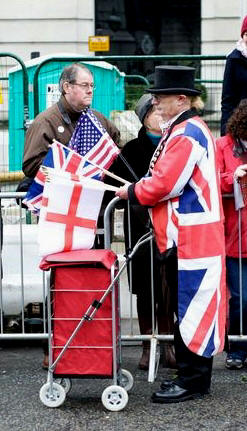|
|
|
|
|
LECCION 37 - PAGINA 2
índice
del curso
página anterior
página siguiente |
|
|
|
 |
Comprehension |
|
|
Read
the article below Then you will have to do three activities
about it. |
|
SELLING THE FLAG |
 |
|
How do you react to a flag-seller
in the street? Do you hurry past on the other side? Do you buy a
flag simply to avoid embarrassment? Or are you among the
minority of willing buyers? Whichever category you fall into,
the attitudes and enthusiasms which marked the birth of the
British flag-day have changed radically over the years.
The flag-day had its beginnings in 1912 and grew rapidly during
the First World War, when £15 million was raised by this method.
Today, perhaps in response to adverse public criticism about
being bombarded on all sides by too many charities, the
Metropolitan Police try to limit flag-days in Greater London to
four major combined onslaughts each year. Local authorities are
permitted six weeks in any one year for such work. Generally
they give preference to local causes. Charity still begins at
home. Many charities, such as the Princess Elizabeth Day
Committee, combine their Greater London flag-day appeals with
those of other children's societies. |
|
It was Queen Alexandra, anxious to
help London hospitals, who introduced Britain to the concept of
selling emblems in support of charity. She got the idea from a
Danish priest who sold roses from his garden in aid of local
orphans. Queen Alexandra decided to sell artificial roses in the
streets every June and the first Alexandra Rose Day was on June
26, 1912.
The roses were made by crippled and blind girls of John Groom's
Crippleage. Under the instruction of Miss Christine May Beeman,
they produced 10 million pink linen roses, each with a capital
'A' stamped on a petal to discourage imitators. Then 15,000
society ladies went into the streets of London in white muslin
and organdie, wearing Gainsborough hats and carrying baskets of
roses supported on red and cream sashes. On that first day
£18,326 was collected. John Groom's Association for the Disabled
(as it is now called) still supplies linen roses, for which it
receives nearly £10,000 each year.
The first day on which flags were sold was in August 1914. Mrs
George, wife of a Monmouthshire engine driver, had the novel
idea of selling flags in aid of the Prince of Wales's National
Relief Fund for the dependants of soldiers and sailors. The
flags were to be of red and white and blue ribbon, stitched to
matchsticks. She wrote to Sir Arthur Pearson, joint Secretary of
the fund, to discover whether she needed special authority to
sell them. Sir Arthur assured her that there was nothing illegal
about her enterprise, which was held in Pontypool and raised
£10.
Many flag emblems of the First World War period were made from
paper, cardboard or silk. Silk flags were expected to produce a
more lavish contribution. The flags were originally fastened
with pins but increasing shortages of metal made new methods
necessary; for instance, a paper emblem with a slit to fasten
over a button. Today, further economies have encouraged the
development of adhesive emblems, which cost 50 per cent less to
produce than the pinned variety, don't require so much storage
space and dispense with hand assembly.
The rapid growth of flower and flag days gave rise to new
regulations concerning street collections from 1915 onwards. The
Metropolitan Police regulations quickly established 16 as the
minimum age for collectors - perhaps reflecting a protest by the
Headmistresses' Association in a letter to 'The Times' about the
exploitation of children on flag-days. Permits to collect were
granted to societies rather than to individuals. Animals were
banned from accompanying collectors because they were said to
cause obstruction, a regulation that may well have frustrated
Nell, the champion Sheffield collie, who collected £60 for the
Belgians.
Today, alternative forms of sponsorship and fund-raising schemes
are increasingly being sought. Oxfam, for example, sells direct
to the public from shops stocked with home-produced and recycled
goods. Ironically, a small batch of charity emblems was recently
given to Oxfam, and items which originally cost only a few pence
were offered for sale as collectors' items ... still in the
cause of charity. |
|
|
|
|
 |
Open cloze |
 |
|
ACTIVITY 152:
Without looking at the original text above, fill each of the
blank spaces with one suitable word. (Some blank
spaces accept more than one alternative). Then check the correct answers. |
|
|
|
|
LECCION 37 - PAGINA 2
índice
del curso
página anterior
página siguiente |
|
|
|
|
|

